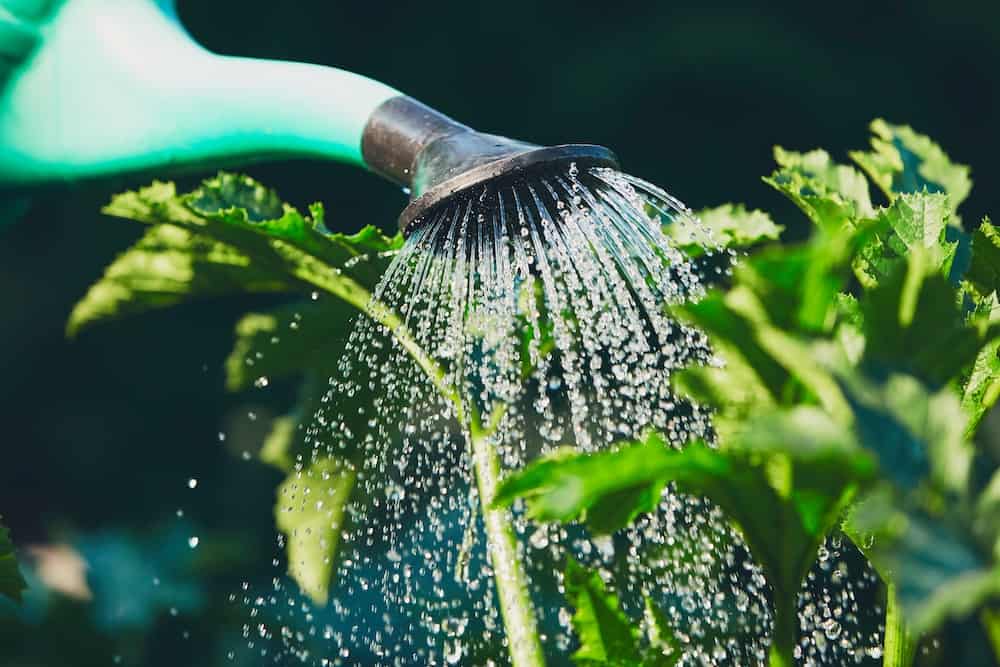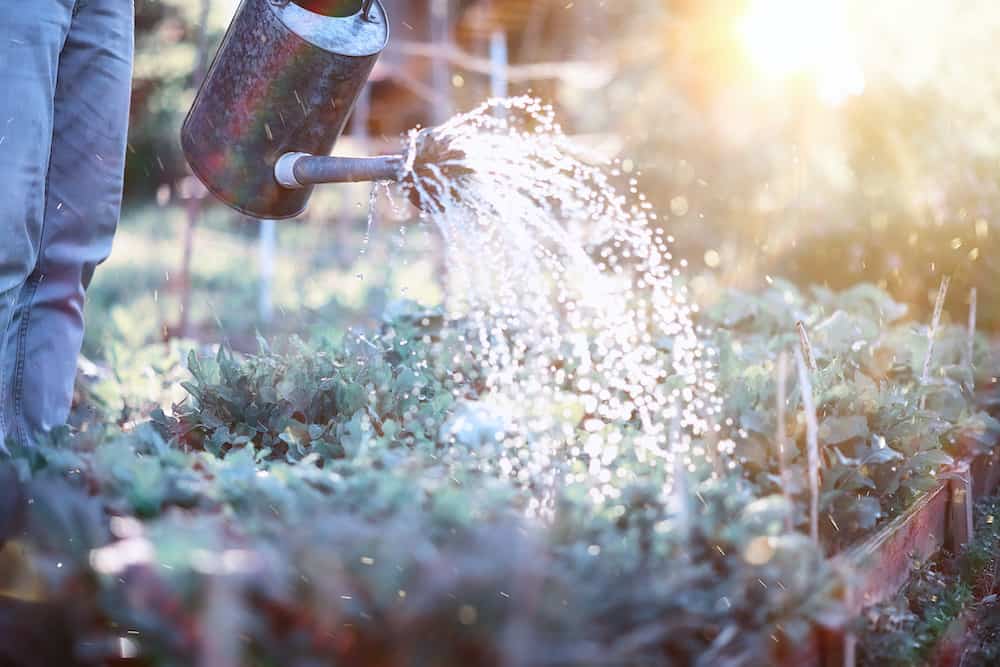When it comes to gardening, it’s essential to understand the different amounts of water that each vegetable needs. Overwatering or underwatering your plants can cause them to die or start to wilt. So, every gardener should ask themselves, “How often should I water my vegetable garden?”.
Many elements go into monitoring your vegetable garden. While water is essential, some factors impact how much water your garden will need. Understanding these factors can help you better water your vegetable garden with ease.
We’ve taken the time to research the various methods for watering vegetables. Listed below are our top tips for ensuring that your vegetable garden thrives this upcoming year.
How Often Should I Water My Vegetable Garden?
As a general rule, you’ll want to water your vegetable garden at least two inches per week. The frequency and amount of water, though, will depend on several factors. These include your soil, climate, rainfall, and what you are growing.
Factors That Affect Your Plant’s Water Needs
Here are the things which affect how often to water your veggie garden.
Soil Quality
A healthy foundation is key to having a thriving garden. The more nutrient-rich your soil is, the more likely the soil will hold onto water. When soil quality is poor, your plants may not grow, may not thrive, or they may die, no matter how much water they receive.
That’s why you must have good soil quality before you even plant your crops.
Land that is dry and falls apart in your hands requires nutrients and water. However, if the soil quality is already decent, you take a bit of soil, and it will stick together. For most fruits and vegetables, loamy soil is best. It holds moisture and is also well-draining.
Make the Soil Better
An excellent way to ensure that your soil is nutrient-rich and healthy is to use compost. Composting before planting helps improve the soil quality and prevents your vegetables from dying.
Using ¼ quarter-inch compost before each season’s plantings can help improve your soil’s quality. If you want to use a tip from the square foot gardening method, you can amend existing soil with equal parts compost, peat moss, and vermiculite before planting.
How to Check Soil Before Watering Plants
Ensuring that the ground doesn’t become completely dry is key to keeping your vegetable garden healthy. Although, you’ll want to ensure that you’re not overwatering the soil either.
First way: A good way to check is to put your finger into the soil, just past your knuckle. If it feels dry, you know it’s time to water. If it comes out with some soil, you can wait.
Second way: Another easy way to check is to use a moisture meter. You can find one at your local hardware store or home improvement center, or online. Simply put the probe into the soil, and it will tell you how moist it is.
Climate
Another key element to knowing how often you should water your garden is to know the climate. Each climate requires a different amount of water due to the humidity levels and weather.
USDA Hardiness Zones
Arid and dry regions, USDA gardening zones 7 – 11, typically need more frequent watering than hardiness zones 1 – 6 which have colder minimum winter temperatures.
The Weather
Sunny and dry climates tend to require more water, while ones with frequent rain may only need a bit of water each week. If you live in an area with lots of sunlight, then you may only need to water your soil once per week. Any more than that and you may risk over-watering your plants.
When vegetables receive too much water, they will begin to have similar symptoms as when they are wilting. On the other hand, places that receive less sunlight and tend to rain more will only require watering once every two weeks.
The key to climate-based watering is always to check the soil quality first. Even if you’re living in a place with plenty of rainfall, it’s a good idea to check the soil’s moisture levels.
Types of Vegetables, Fruits, and Herbs You are Growing
Knowing the types of vegetables in your garden can help you understand how much water they need. The frequency of watering will also change depending on what kind of vegetable you’re growing. In general, there are a few different factors that you should keep in mind, such as:
Size
It should go without saying, but the size of the plant will influence how often you should water it. More abundant vegetables will require more water than smaller ones. Additionally, larger vegetables will need to be watered frequently.
Roots
Vegetables that have root systems will be more efficient at absorbing the surrounding water. This may require the plants to be watered less frequently.
We always recommend checking the type of plant to ensure you’re giving it enough water. Some plants even require daily watering.
Potted vs Outdoor
You may not realize it, but potted plants need to be watered less than outdoors. The main reason is that any plant placed in a pot without drainage at the bottom will continue to hold onto water.
Water that isn’t absorbed will just sit at the bottom of the container and can cause the plant to become over-watered if continuing to give more water than necessary. That said, vegetable types play a huge role in how much water is needed.
A root vegetable may need more water during the first few sprouting months, while a fully grown berry bush may only need a bit of water periodically depending on the rainfall in the season.
It all depends on what type of plant you have. Doing your research on each vegetable can help ensure that you’re not over or under-watering.
Sunlight
The frequency of sunlight will profoundly impact the amount of water your garden needs. If you live in a naturally bright climate, you may need to make adjustments to your vegetables.
Creating shade and blocking out some sunlight can help assist with soil quality. Plants in your garden will start to dry out if they are exposed to too much sunlight.
An excellent method to test the sunlight exposure is to water your plants. If, by the end of the day, the soil feels dry to the touch, then we recommend adjusting the frequency you water your vegetables.
Remember, sunlight changes depending on the time of year and weather. While some days it may be very bright and humid, others may be cloudy and dry. It highly depends on what region you’re living in. Taking this into account can help save you from accidentally over or underwatering your plants.
Ways to Measure the Amount of Water Used

Pipe Probe to Check Moisture
Using a pipe probe can help you keep track of how much water you’re providing the plants.
Moisture meter to check soil’s moisture
A moisture meter may come in handy as you can also use some of them to check the light as well as the pH level of the soil. We use the Hydrofarm 3-Way Meter. (I bought it at my local Ace Hardware though it’s available at other home improvement stores as well as Amazon.) Monitoring the amount of water can help prevent how much water the plant needs.
Some young vegetables may only absorb so much water per day. Ensuring that they have enough water will help optimize their growing speeds.
Another method to measure water is to water the vegetables via an overhead sprinkler. Take a bucket or small container and place a few around the garden. Water your plants as usual and, by the end of the day, measure the remaining moisture.
Placing multiple containers helps give you a more accurate reading. Plus you’ll want to measure the water by either gallons or inches. When the containers reach one inch, that means one inch of water has been applied to the garden.
Factors Affecting Water Level Measurement
While the methods can give you an accurate reading, you will still need to watch for a few factors that influence the measurements, including:
Ground Angle
Ensure that your garden isn’t tilted or placed on uneven ground. When gardens are built on a hill, then the water will start to run downhill. This can affect the amount of water that each of your plants gets.
Sun Exposure
Always monitor the amount of sunlight and if any fixtures are in the way. Gardens placed partially behind buildings or around trees may get less sun exposure, which could affect water absorption.
Current Season
Each season will affect the absorption rate of water. It’s not uncommon for vegetables to need different amounts of water depending on the season.
Pot Used
Any plants placed in pots or containers will need less watering. Unless they have built-in draining pots, chances are they will become overly watered if watered daily.
Plant Wilting or Drying
Any plants displaying wilting or dying symptoms may actually just be over-watered. It is a good idea to monitor how much water you’re giving a plant. If you cut back on the water and the plant goes back to normal, then you can assume that the water was the issue.
In addition, use the exact name of what is growing and do some research. Find out what signs of leaf distress mean for that plant. In this way, you will learn whether you are over-watering or under-watering.
What Tools Can Help Water My Vegetables?
The traditional hose with a spray attachment is generally the best method if your garden isn’t that big. However, medium-sized and larger gardens could benefit from using a built-in sprinkler system.
These systems often allow you to customize the amount of water released each day. Some even come with built-in timers to help manage the frequency of watering.
Does Time of Day Impact How Much Water My Garden Absorbs?
The best time to water your vegetable garden is early in the morning. This is when there is less sunlight, and more of the water is likely to be absorbed. If watering during the middle of the day, sunlight may cause some of the water to evaporate.
If you can’t water your plants during the morning, then the best alternative is during night time. The late afternoon or the early evening will optimize how much water is absorbed by the soil. As long as you wait until the sun is setting, you’ll be able to ensure your vegetables get enough water.
Should You Mulch?
If all else fails and you notice that your vegetables are losing water or showing signs of wilting, then there is one alternative. Mulching is a technique that helps the soil conserve water. This is best for climates with less than 40 inches of annual rainfall.
Mulching is a technique where you take a material and spread it over the surface of the soil. This technique helps prevent moisture loss on the surface of the ground. It also prevents water loss and keeps the surface of the soil regulated.
How Often Should I Water My Vegetable Garden?
Crops tend to vary in frequency and amount of water needed to keep them alive. Vegetables are extremely variable on the amount of moisture necessary to stay alive. Many plant types tend to absorb water at different rates depending on their stage of development. Using our tips can help you avoid under-watering or over-watering the crops and prevent water loss.
Rainwater Collection: A Complete Guide to Collecting Rainwater

